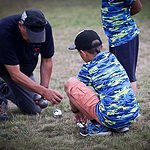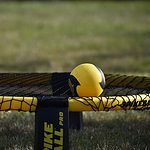Imagine your badminton racket as a finely tuned instrument, each string playing a crucial note in the symphony of your game.
But what happens when one of those strings snaps or frays? Can the harmony be restored, or is it time to retire the racket altogether?
Let's explore the possibilities of repairing badminton strings and discover if a simple fix can revive your racket back to its former glory.
Key Takeaways
- Badminton strings can be repaired through string tension adjustment and timely maintenance.
- Regular inspection and maintenance prevent string breakage and enhance performance.
- Professional stringing services offer expertise in selection and precise stringing techniques.
- Customization options tailor strings to player preferences for durability, control, and power.
Common Causes of String Breakage

Understanding the common causes of badminton string breakage is crucial for players looking to maintain the durability and performance of their equipment. To prevent premature damage, make sure to be aware of the factors that can lead to string breakage.
High tension in the strings, often used to enhance power and control, can also make them more vulnerable to breakage. Additionally, frequent and intense use of the racket can put strain on the strings, increasing the likelihood of them snapping. Improper stringing techniques, such as uneven tension or incorrect knots, can weaken the strings and make them more prone to breakage during play.
Hitting the shuttlecock off-center or with excessive force can also contribute to string breakage. Over time, strings naturally weaken and fray, making them more susceptible to snapping. Therefore, it's essential to regularly inspect and maintain your strings to ensure they remain in optimal condition for your games.
Types of String Damage
String damage in badminton rackets can manifest in various forms, including fraying, notching, tension loss, and breakage. These types of damage can impact the durability and performance of the strings, affecting your overall gameplay.
Here's a breakdown of the different types of string damage:
- Fraying: This occurs when the strings start to unravel and weaken over time due to continuous use. Proper string maintenance and repair techniques are essential to address fraying and prolong string life.
- Notching: Notching is characterized by grooves or cuts in the strings caused by repeated impact with the shuttlecock or racket frame. It can significantly affect string tension and playability, highlighting the importance of regular checks and repairs.
- Tension Loss: Gradual tension loss occurs as strings stretch and settle during play, leading to a decrease in performance. Monitoring string tension and its impact on play is crucial for maintaining consistency in your game.
Can Badminton Strings Be Repaired?

To efficiently restore badminton strings, proper techniques such as adjusting the timing device can be employed. String tension adjustment is crucial in maintaining optimal performance on the court. Regular string maintenance techniques are essential to prevent breakage and ensure longevity. String inspection for wear, fraying, or notching is necessary to address issues promptly and avoid further damage. Keeping strings clean from dust and dirt can significantly extend their durability and performance.
| String Repair Techniques | Description | Benefits |
|---|---|---|
| String tension adjustment | Adjusting tension levels | Enhances performance |
| Timing device repair | Repairing timing mechanisms | Restores string functionality |
| String inspection | Regularly checking strings | Identifies issues early |
Tools and Materials Needed
You'll need specific tools and materials to effectively repair badminton strings, ensuring optimal performance on the court.
Tools and Materials Needed:
- Stringing Machine, String Cutter, Awl, and Pliers: These tools are essential for proper stringing techniques and maintenance.
- Replacement Strings, Grommets, and Grip Tape: These materials are crucial for maintaining string tension and durability during the repair process.
- Different Types of Strings (e.g., nylon or synthetic gut): Proper string selection is key for achieving desired performance outcomes on the badminton court.
Using the right tools and materials is vital for the successful repair and maintenance of badminton strings. Following manufacturer guidelines will help you achieve the best results in terms of string tension, durability, and overall performance. By having the necessary tools and materials on hand, you can ensure that your badminton strings remain in top condition, allowing you to play your best game every time.
Step-by-Step Repair Process

Start by identifying the damaged area on the badminton string, such as fraying or notching, to initiate the repair process effectively. Once you have located the damaged section, carefully use a string cutter to trim any frayed or weakened parts of the string. Make sure to adjust the string tension correctly using a stringing machine to maintain proper alignment. Next, securely knot the repaired string to prevent unraveling during play. It's crucial to test the repaired string by hitting a few shots to ensure it's secure and functional before resuming play.
Engaging in regular string maintenance and performing DIY repairs can significantly extend the string longevity of your badminton racket. By following these step-by-step repair processes, you can save time and money by avoiding frequent string replacements. Remember, a well-maintained string not only enhances your gameplay but also prevents unexpected string breakage during crucial moments on the court.
Tips for Preventing String Breakage
Inspecting badminton strings regularly for signs of wear, such as fraying or notching, is essential to prevent string breakage. To ensure your strings last longer and perform optimally, follow these tips:
- String maintenance and preventive measures: Keep your strings clean from dust and dirt by wiping them down after each use. This simple practice can help maintain the integrity of the strings and prevent premature breakage.
- Extending string lifespan with care tips: Maintain proper tension levels in your strings to prevent sudden breakage during play. Proper tension not only enhances performance but also ensures the longevity of your strings.
- Avoiding string breakage with maintenance strategies: Store your rackets in a suitable environment that avoids extreme temperatures. Extreme temperatures can weaken string tension over time, leading to potential breakage. Additionally, re-string your rackets periodically based on your frequency of use to prevent sudden breakage and maintain optimal performance.
When to Replace Strings Instead

To ensure optimal performance and prevent potential injuries, it's crucial to replace badminton strings promptly when they exhibit signs of wear, lose tension, or feel 'dead'. String tensioning plays a vital role in the playability of your racket. When strings lose tension, they can no longer generate the power and control needed for effective shots.
String maintenance is key to prolonging string durability. Regular players should restring their racket every 20-30 hours of play to maintain consistency in their gameplay. Signs such as fraying, notching, or breakage indicate that it's time for a replacement. Strings with visible wear or damage can significantly impact shot accuracy and control, underscoring the importance of timely replacements.
Proper string maintenance practices, coupled with timely replacements, are essential for maximizing playability and preventing injuries on the badminton court.
Professional Stringing Services
Engage professional stringing services to benefit from expert knowledge in selecting the ideal string material and tension for optimal badminton racket performance. Professional stringers use specialized machines that ensure precise and consistent string tension across all strings.
Here are some key advantages of utilizing professional stringing services:
- String Tensioning: Professionals can accurately adjust the tension of each string to meet your specific playing requirements, enhancing control and power in your shots.
- String Material: With their expertise, professional stringers can recommend the most suitable string material based on your playing style, whether you prefer durability, control, or power.
- String Customization: Professional stringing services often offer customization options, such as hybrid stringing or specific string patterns, to tailor your racket to your individual preferences and playing needs.





